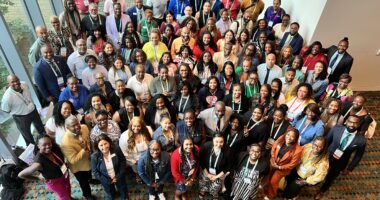Lead Like a Llama
The best leaders lean into their strengths, embrace them fully, and use them for the benefit of others—just like a llama. Learn how to lead like a llama to guide—and guard—your school community.

Educational leadership is difficult, especially when times are hard and people are struggling. In these moments, our true and complete selves are put on display. Our strengths emerge for sure, but so do our weaknesses. I don’t know about you, but I have a lot of weaknesses, especially when compared to others.
Comparison Is the Thief of Joy—and Confidence
I recently attended the NAESP 2023 Pre-K–8 Principals Conference in National Harbor, Maryland, and I came away inspired and encouraged, with a bag full of new ideas to implement. I also came away discouraged.
I’m not nearly as intelligent as principal Baruti Kafele, I thought after attending his powerful session on equity.
“I’m not as intentional as Danny Bauer,” I said quietly to myself after leaving his session on how to live and lead on your terms.
I’m not … I’m not … I’m not …, I thought more often than I’d like. I wish I were more like them, I thought.
Leading With Humility
But I’m not. I’m me. You are you. And whether we like it or not, this is what we have to work with. This is what we have to lead with. Recently, I have discovered that it is more than enough.
In my office, above the door, I have a picture of a llama. My school’s mascot is the Grizzly Bear, and although I wish I were more like that—strong, confident, and unafraid—I find that I resonate more with the llama—awkward, underwhelming, and seemingly insufficient for the task at hand.
But a llama, not a grizzly or a lion, is exactly the type of leader—the type of person—I want to be, that I need to be. Grizzlies and lions aren’t asked to defend the sheep. Llamas are.
In his book Humilitas: The Lost Key to Life, Love, and Leadership, John Dickson argues that we have an incomplete understanding of humility. Humility is absent of arrogance, but it is also confidence in one’s strengths, abilities, and resources. Complete humility, he writes, is “the noble choice to forgo your status, deploy your resource, or use your influence for the good of others before yourself.”
For us to use our gifts and resources fully and completely for the good of others, we must fully and completely understand the gifts and talents that we have.
“It is impossible to be humble,” Dickson writes, “without a healthy sense of our own worth and abilities.” Just like a llama.
Llamas do not have claws. They don’t have sharp teeth, a loud roar, or an intimidating appearance. Instead, they are goofy looking and radically unintimidating. They have no business being tasked with guarding a flock. Yet, they are. And they do. From a myriad of predators, like wolves, dingos, coyotes, and foxes, often by themselves. How? By acknowledging what they are and forgetting what they are not. We might not be as smart as the principal next to us, as talented, charismatic, or confident as the one to our left, our right. But that doesn’t mean we aren’t the perfect llama to lead our schools.
Every leader has their weaknesses, flaws, and shortcomings. The best leaders, however, lean into their strengths, embrace them fully, and use them for the benefit of others—just like a llama.
Guiding—and Guarding—Our School Communities
Sometimes, our greatest strength is that we are here. That we have been tasked with guiding our schools, supporting our staff, and caring for our students. We are. And we are capable of doing an amazing job if only because we love our people.
And because we love our people, we are prepared to use whatever gifts, talents, and resources we have to care for those in our care. Just like a llama.
As a leader, you, more than anyone, are aware of your shortcomings. Don’t rest in them. Simply acknowledge them and then surround yourself with people who can fill in the gaps, who can compensate. Then, lead your staff with patience and grace.
Like a llama who stands guard, confident, and ready to protect, you too are fully aware of your strengths. Don’t downplay or shy away from them; embrace them—just like a llama—and lead your staff with conviction, passion, joy, and purpose.
When the fear of doubt creeps in, as it most assuredly does to all who lead, when you begin to think and start to believe that you are not good enough, look in the mirror and acknowledge the llama before you—weaknesses and all. And more important, call out your gifts, talents, and resources, and remind yourself of who you are, what you are, and the amazing, dedicated leader you are. Then, just like a llama, confidently and passionately strive to give them away.
Dickson reminds us that humility is “more about how I treat others than how I think of myself.” And llamas, I assume, spend very little time thinking about themselves. How could they? They have their flock to care for. And so do we.
So be strong, courageous, and with confidence, love and protect your people. Lead like a llama.
Brian Miller is principal of North Middle School in Great Falls, Montana.




